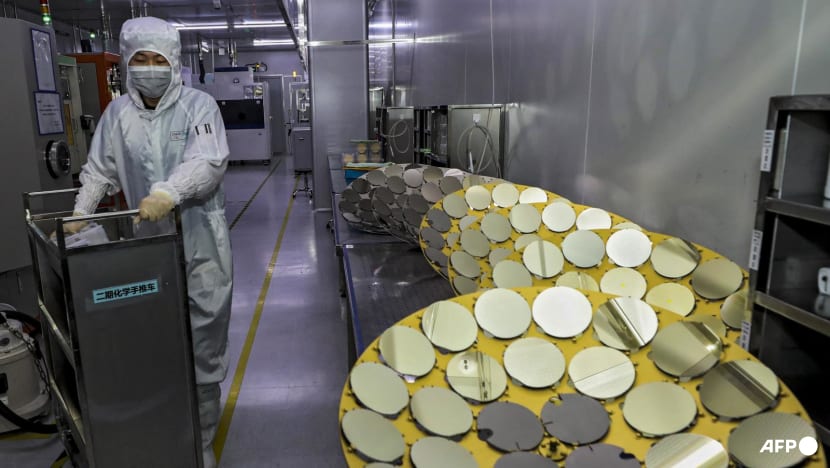Commentary: China ban on Nvidia chips is not just about a trade spat
By doubling down on Huawei and domestic chipmakers, China shows it is willing to lose ground now to achieve its AI future, says IMD’s Howard Yu.

An employee works at a semiconductor chips factory in Huai'an, in eastern China's Jiangsu province on Apr 29, 2024. (File photo: AFP/STR)

This audio is generated by an AI tool.
LAUSANNE, Switzerland: China has put its near-term progress in the global AI race with the United States on the line. By banning its largest tech companies from buying Nvidia’s chips, Beijing is forcing ByteDance, Alibaba and others to rely on Huawei and other domestic suppliers.
It is a gamble, but the world’s second-largest economy has clearly concluded that relying on American technology is now more dangerous than going it alone on semiconductors.
Beijing appears to have grown tired of the US' erratic policymaking under President Donald Trump – from sweeping tariffs on Chinese goods to repeated changes in rules on advanced chip exports. The Trump administration first imposed, then abruptly lifted, an export ban on Nvidia’s H20 chip, underscoring the policy whiplash facing Chinese tech firms. Beijing is now urging Chinese firms not to buy the chip at all.
In September, regulators at the Cyberspace Administration of China also told tech giants to stop buying Nvidia’s RTX Pro 6000D, a chip tailored for the Chinese market in compliance with US export restrictions and widely used for AI. Officials believe that domestic products are now good enough, reducing the need for Nvidia’s hardware.
The ban may look heavy-handed. But what matters is the outcome.
HUAWEI, CHINA’S ANSWER TO NVIDIA?
By removing the option of Nvidia, Beijing is forcing its tech giants to rely on local chips, a move to accelerate the growth of its domestic semiconductor sector and build self-sufficiency.
Huawei is now at the centre of this plan, though Beijing is also encouraging the use of other domestic chip suppliers like Cambricon, Alibaba and Baidu.
At its recent conference in Shanghai, Huawei unveiled new supercomputing systems powered by its Ascend chips, claiming they can link more than a million processors. Such scale is essential for training today’s largest AI models, and with a roadmap of new chips through 2028, Huawei is presenting itself as China’s alternative to Nvidia.
Huawei’s claims may be technically impressive, though they have yet to be independently corroborated. But in AI, raw power is only part of the story. Success depends on the surrounding ecosystem.
FORCING INNOVATION TO ACCELERATE
If regulators had not intervened, companies like Alibaba and Tencent would likely have kept buying from Nvidia. The American company’s chips, software and support ecosystem are still more mature and widely trusted than domestic alternatives. The software built around its chips over nearly two decades are a formidable “moat” that competitors have struggled to cross.
In the short term, China’s AI progress may slow. Blocking access to Nvidia chips could delay the rollout of advanced AI features across Chinese platforms for 18 to 24 months – much like when Huawei lost access to Google’s Android system in 2019 and launched its proprietary HarmonyOS 2.0 for mobile devices in 2021.
Huawei’s hardware is improving, but it still lags Nvidia, especially in software tools like CUDA, which help developers fully tap into chip power.
That kind of ecosystem takes time to build. Without enough users, optimisation is slow. Beijing’s gamble is that, by forcing adoption, it can break the chicken-and-egg cycle and accelerate domestic innovation.
TWO-TRACK AI ECOSYSTEM
For Nvidia and other global firms, the key takeaway is that access to China’s market is now far less certain than before. Companies must prepare for the possibility that AI systems will diverge, with one path aligned to US standards and another built around Chinese technology.
China has many of the ingredients needed to sustain the divergence. One recent analysis counted more than 950,000 AI papers from Chinese researchers, compared with about 1.36 million from the US. China now has a larger pool of AI scientists, more than 105,000 compared with around 94,000 in the US.
That makes hedging essential: A company tied only to the US or only to China risks being shut out of the other.
How companies hedge between AI ecosystems depends on the industry. In life sciences, for example, running drug discovery or clinical trials requires access to local data and regulatory approvals in both markets. That means companies increasingly need “two tracks” of infrastructure – separate AI models, IT systems and clinical workflows – to stay competitive.
Using US tools alone may not cut it in China, and vice versa. This is the kind of dual approach some firms are already adopting to stay relevant in both ecosystems.
The broader lesson is that innovation needs consistency. Industries such as AI, biotech or clean energy only thrive when governments stick to policies over years rather than flip-flopping. Frequent reversals kill investment.
In the race to shape the future of AI, China is playing the long game – and it’s willing to lose ground now to control the terrain later.
Howard Yu is the LEGO® Professor of Management and Innovation at IMD business school in Switzerland and serves as Research Director of the Center for Future Readiness.



















